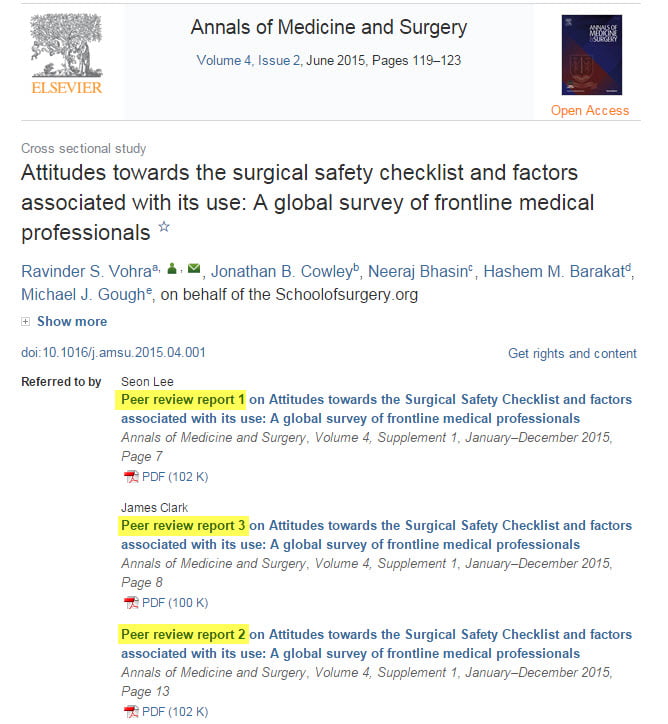Peer review has been the foundation of quality in scientific publishing for hundreds of years, but continues to evolve as publishing progresses. At Elsevier, we are piloting several new innovations in peer review to make the process more transparent and to value the contributions reviewers make to building our collective scientific knowledge.
We’re partnering with Sense About Science to promote the inaugural Peer Review Week 2015, “a virtual event to celebrate the fundamental role of peer review in maintaining scientific quality.” Of course, peer review takes place all year round, and we’ve been busy working on several new projects to support peer review.
Contents
Open peer review
Traditionally the peer review process has been closed and reviewers – and their reports – have remained anonymous and locked away, even long after review. While this is still preferred in many cases, some pioneering journals are taking part in our trial to publish peer review reports as articles, next to the research they review.
In the Publishing Peer Review pilot, participating journals publish the peer review reports next to the articles on ScienceDirect, like this article in the Annals of Medicine and Surgery. When an author submits a manuscript, they are informed that if their article is accepted, its reviews will also be published. The editor also informs reviewers on invitation that their reviews will be published; they can then choose whether to stay anonymous or reveal their name.
The peer review reports are not reviewed but are typeset in the same format as the article and published with a separate DOI. When the research is published, the review reports are shown at the top of the page on ScienceDirect, in a ‘referred to by’ list. The reports are all freely available for both subscription and open access journals.

This open review approach gives credit to reviewers for the time and effort they put into improving the quality of the manuscript and shows the community that the journal is running a proper peer review process. It also has a learning element: it provides early career researchers and young reviewers a resource of peer review reports, giving them a sense of what a good report looks like.
So far, the pilot has been popular: around 400 review reports have been published since February this year. We surveyed reviewers and, of those who declined the invitation to review, only 9% said it was because of the openness of the reviews. Of the people who accepted, 45% wanted to stay anonymous because they consider it unnecessary to be named, or think the quality of review would be jeopardized as a result. Many reviewers also said they would spend longer on the review to ensure it was of publishable quality.
The pilot will run until the end of the year, at which point we will decide whether to expand to further journals. In the meantime, we are also planning to add more information about peer review to every Elsevier journal. At the top of an article on ScienceDirect, you can see the article history details – acceptance and publication dates. We plan to add peer review details here, for example, the number of review reports the manuscript received.
Collaborative peer review
Sometimes editors can have a challenging time making a decision about a manuscript, especially if the review reports and recommendations are contradictory. In cases like this, it can be helpful to have a discussion with the reviewers to come to a conclusion; that’s what our Cross Review pilot is all about.
With Cross Review, editors and reviewers come together in a closed online forum to discuss the review reports and recommendations. First, the editor uploads the submitted review reports to the forum and poses questions that help guide their decision. They then invite the reviewers, who can stay anonymous if they prefer, to the forum to answer the questions. The forum is live for a short time – it lasts only 48 hours – to ensure the discussion does not delay the review process. The editor then summarizes the discussion and informs the authors and reviewers of the discussion and his or her decision.
The pilot builds on a previous project in Mendeley, which proved popular with reviewers, editors and authors: reviewers felt involved in the decision making process, editors could make clear decisions and authors improved their manuscripts. However, it was not technically feasible for reviewers to stay anonymous in the private groups created by the editors on Mendeley. Therefore, we are now working using a forum that is built on a different platform.
Innovations like open and collaborative peer review mean the world of peer review will look very different in the near future due to the huge opportunities the internet, online technology and social media provide us. Elsevier continues to work on new approaches to peer review; applying such innovations to large portfolios of journals will have a big impact on the peer review process and academic publishing in general.
Recognizing reviewers
Reviewers are fundamental to the peer review process. Most often anonymous, they work hard to assess and help improve manuscripts, contributing their time and expertise to the work of other researchers. Yet reviewers don’t tend to get the credit they deserve for the effort they put in to ensuring published research is high quality.
A year ago we decided to change that, and we piloted the Reviewer Recognition Platform with 40 journals. The platform lets reviewers track their reviewer status, access an annual report of their reviewing history and volunteer to review for other journals. It also enables them to claim discounts for books and author services purchases, collect certificates of recognition. Reviewers can even ‘claim’ peer reviews they have done for non-Elsevier journals to add to their profile.

The response to the pilot was enthusiastic, so we rolled the platform out to more journals. As of this month, almost 900 journals are connected to the Reviewer Recognition Platform, with more than 50,000 reviewer profile pages. By the end of the year, we aim to include all of Elsevier’s journals – more than 2000.
Recently we added the Reviewer Page to the platform, where reviewers can have a list of the review reports they’ve written for Elsevier and non-Elsevier journals. The page helps reviewers keep track of the reviews they’re doing across the board, so it’s important that it’s publisher-neutral. We’re currently in discussion with other publishers to set up a system for them to verify review reports for their journals.
We piloted the Reviewer Page in August with 50 journals. Within a day of informing reviewers of the new feature, more than 300 pages were created; this shows the value of profiling review work, particularly for early career researchers.
[“source=elsevier”]








